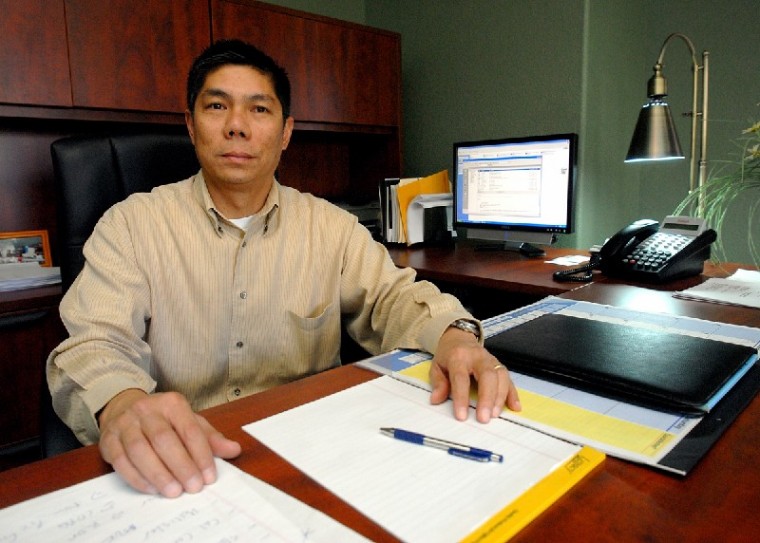Director moves from SoCal to San Benito
Bill Chow’s second story Redevelopment Agency office in the
Porter House at the corner of Monterey and Sixth streets offers an
impressive look at downtown Hollister.
His view of the streets, rooftops and treetops gives him a
unique perspective on what many hope will become a bustling,
shopper-friendly, and ultimately, sales tax-generating area.
Director moves from SoCal to San Benito
Bill Chow’s second story Redevelopment Agency office in the Porter House at the corner of Monterey and Sixth streets offers an impressive look at downtown Hollister.
His view of the streets, rooftops and treetops gives him a unique perspective on what many hope will become a bustling, shopper-friendly, and ultimately, sales tax-generating area.
In his third week on the job as director of the Hollister RDA, Chow, who spent 14 years with the city of Huntington Park in Los Angeles County – including the past four as redevelopment and economic development manager for the city of approximately 70,000 – is still getting a read on the community.
With the expected lifting of the sewer moratorium by the end of the year, Chow said the city is in a position to improve its economic vitality.
He said he will work in conjunction with Hollister economic development manager Jeff Pyle “to revitalize the downtown and to take advantage of the opportunities that the city has as far as redevelopment and economic development are concerned. They go hand-in-hand.”
Chow, who earned an economics degree from the University of California, Santa Cruz, said there was no redevelopment in Huntington Park when he started working there.
“There was no private investment by developers or banks. It was very difficult,” he said.
As head of that city’s RDA, he focused first on providing market-rate and affordable housing, a need he sees in Hollister as well.
“Once we were able to entice developers to come into the city and develop multi-unit, condominium, townhome and single-family projects, then we were able to focus on the commercial development and manufacturing,” Chow said.
The opportunity to work on the challenges of redevelopment is what enticed Chow to pursue the Hollister redevelopment job.
“This is an opportunity to take on the challenge of a city that I am familiar with and to implement another successful redevelopment program,” he said.
Hollister’s location, miles away from Hwy. 101, has dissuaded some national retail and restaurant chains from opening here.
“Being away from other areas is sometimes a good thing and sometimes a bad thing,” said Chow, “especially when you can’t take advantage of (Hollister’s proximity to) other markets like Gilroy, Morgan Hill, and Salinas. Hollister is its own island,” but that fact also makes it a challenge to market the area to national tenants.
Chow said it took him three years of “begging, pleading and kissing hands” before Home Depot decided to open a store in Huntington Park. When it did, however, other investors and large retailers followed.
“Hollister has to plan for itself by providing more rooftops,” or development, Chow added. “More rooftops mean more people working in the city of Hollister and hopefully they’ll spend their money here.”
A large influx of housing in early- to mid-1990s brought a number of homes to Hollister, but it also overtaxed the local sewer facilities, ultimately prompting the state-mandated ban on development. With that problem addressed with the city’s expanded sewer treatment plant, Chow is optimistic.
First, however, the city must also address what he calls “sales tax leakage” caused by Hollister residents spending money in surrounding communities such as Gilroy, Salinas and San Jose.
“Good marketing of what the city has will help” reverse that trend, Chow said. “Once the development starts taking place then we can focus the consumers to the locations in Hollister where we’re going to bring new development. We need to cater to the different market segments and age groups.”
Pyle is working on a retail trade analysis that is looking at sales tax leakage issues and Chow intends to work with local groups to address the problem.
He said he will meet with Realtor groups because “they know things that nobody else knows” about businesses’ plans. “We’ll also work with business groups like the chamber of commerce and the Hollister Downtown Association. If we’re losing sales tax dollars to another city, why not work to bring those businesses to downtown Hollister?”
The city’s redevelopment budget is expected to be in the $20 million range this year, Chow estimated, though he said he hasn’t yet seen an exact budget.
Redevelopment is a tool provided to local governments to eliminate blight in a community and to spur economic development using tax increment funds, or the increase in tax revenues created by improvements to a specified area.
“It allows cities to target areas of need to invest in infrastructure, capital improvement projects like streets or sewers, and to help revitalize a blighted area,” Chow said.
Hollister’s RDA is involved in the redevelopment of the old Fremont School site on Fourth Street, which is being considered as the future site of the San Benito County Courthouse. Chow said the RDA continues to look into the feasibility of continuing development at the 400 Block project at the corner of Fourth and San Benito streets.
The construction of the parking garage and the accompanying Gavilan College site was an RDA project. At issue is how – or whether – to develop the rest of the area at the busy downtown corner.










